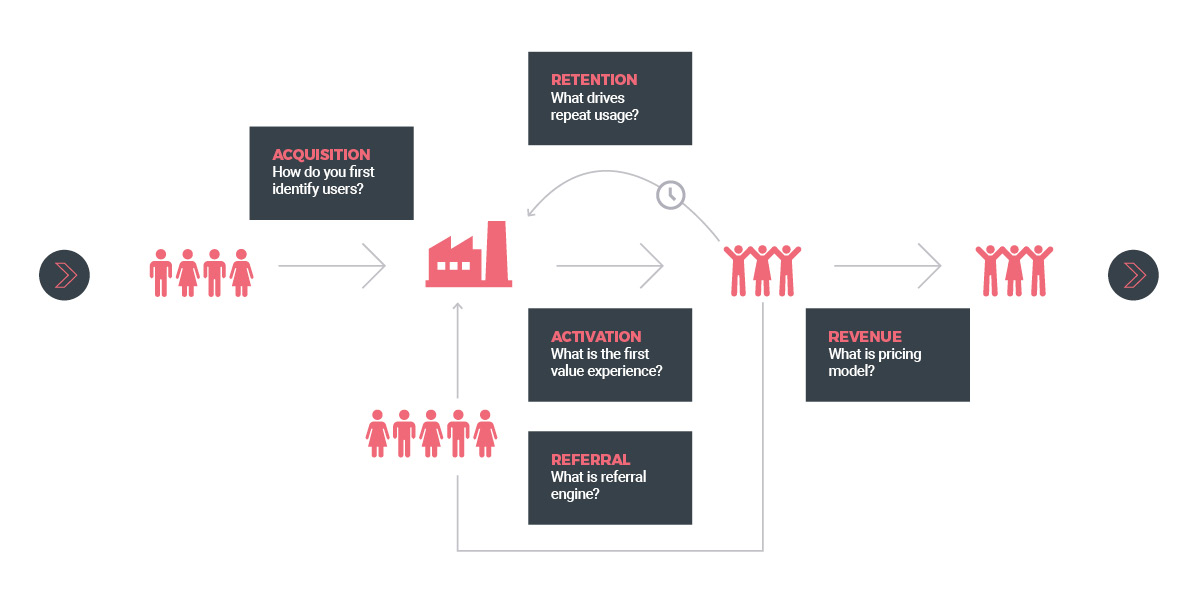Today’s destination marketing organizations (DMOs) are wrestling with their relevance. For some, it’s an existential crisis. Their stakeholders are changing, consumer behaviour is leading disruption, revenue streams are drying up and being replaced, and destination marketers find themselves redefining their role.
Without a clear value proposition, demonstrating relevance is an impossible task.
Finding relevance through the right business models
In his book on startup companies, Scaling Lean, Ash Maurya describes a simple way to understand current business models. The diagram below illustrates the path from customer acquisition to revenue.

From Ash Maurya’s Scaling Lean.
The goal of a modern business model is to create happy customers. That happy customer factory in the middle of the diagram represents the product, service, or experience that gives customers the value they were looking for. It’s the core purpose of your business.
Surrounding that goal, Maurya’s model identifies three ways to grow your business: acquiring new customers; retaining customers to gain repeat business; and referral, which is another way to find new customers and increase revenue.
What can DMOs learn from this to become more relevant as they lead their destinations? It starts with the right objective.
A destination’s role is to deliver experiences that make visitors happy.
This definition of success looks beyond revenue and toward a holistic approach that involves residents, visitors, and the tourism industry, for starters. But a tourism destination is an ecosystem that requires revenue to function. Maurya’s model shows three growth engines that are important for destinations to understand.
Three growth engines for destinations
1) Visitor Acquisition
Destinations following an acquisition model invest in communications to directly reach consumers. They also build B2B relationships with trade and media to bring in business indirectly.
From a consumer marketing perspective, this means:
i) Outbound marketing through broadcast advertising, which includes television, radio, banner ads, billboard, paid web traffic, paid Facebook fans, etc. This includes any one-way communications and all paid and owned media efforts.
ii) Inbound marketing. This means building relationships over time by adding value to the visitors’ path to purchase. Tactics include digital marketing such as SEO, organic web traffic, content, social media, and email. These relationships can generate earned media over time as visitors or potential customers build a connection with the destination.
2) Visitor Retention
Destinations like USUS AS (formerly Visit Sørlandet) in Norway have made increasing repeat visitation their goal. For example, fishing lodges or heli-ski operators can encourage guests to book next year’s trip while they are still in the destination and the experience is fresh in their minds. The ultimate success for a destination like this would be 100% repeat visitation.
3) Visitor Referral
This approach is especially important for long-haul destinations. Visitors who embark on a bucket list trip and have a memorable experience are likely to tell their friends. If your destination can create a referral rate of 1:1 or higher, it will grow. Net Promoter Score (NPS) is a valuable tool to measure satisfaction and the likelihood of referral. Word of mouth is critical here, so earned media tactics are valuable. These may include PR, influencer marketing, resident advocacy, user-generated content, and more.
These three growth engines apply beyond destination marketing. Take Starbucks for example. The coffee chain discovered that the more time people spend in their stores, the more that store’s revenue increased. What’s the DMO equivalent? Destinations can use NPS to measure and improve the visitor experience, which will lead to increased repeat bookings, higher engagement and potential for referrals.
The hardest input to justify in the current model is spending to increase the size of your advertising audience. What good is higher reach if your experiences are inadequate? What’s the throughput of your destination’s marketing efforts? What can you correlate to future revenue?
Based on the three growth engines, destinations have new options:
1) Continue to reach people through advertising.
Craft a compelling enough message to cut through the noise and induce enough potential visitors to go to through the path to purchase on their own. The business case here works when the return is greater than the spend.
2) Invest in inbound marketing.
Grow relationships with enough people so that you can help a large percentage of them decide to visit your destination. The argument here is that you will invest in a valuable audience for the long term. The return on investment (ROI) is harder to measure immediately, but will require fewer dollars spent on media. The audience becomes an asset managed and maintained by the DMO on behalf of the industry.
3) Build experiences that make people happy.
Under this approach, the DMO is responsible for leading the vision to not only improve visitor experience, but also to ensure an improved quality of life for residents. This can create a win-win situation with quality, profitable tourism. DMOs can work to:
- Turn healthy tourism into the gateway for economic development. No one moves to a new city without visiting it first. Visitor experiences are important beyond tourism, as the flow-on effects across industries help maintain a place’s overall brand.
- Improve repeat visitation by connecting experiences with inbound marketing. Marketers need to focus their relationship management and experiences on building an audience of repeat visitors.
- Ensure that visitors become raving fans of your destination. When they do, your visitors will become your best marketers.
- Become a resource to help your industry deliver better experiences through education.
- Help tourism operators better communicate with their guests through digital channels.
Which model will help your DMO thrive and stay relevant?
These three options are effectively the new business models for destinations. Many DMOs are still focused on option 1, seeking to reach people through advertising. The destination marketing industry has built very good advertising companies, but that approach is not as effective today.
The other two models open up exciting alternatives. Through more than a decade of experience, I’ve observed (and Destination Think has helped) some DMOs experiment with options 2 and 3.
My advice? Identify which business case is the most valuable for your industry. Create an organizational plan. Be transparent in your approach, and overcome fear of change. Turn change to your advantage, and you can guide your destination to greater success.
Want to find out how today’s destinations are addressing change? Download the “Leading your destination into the future” whitepaper, the result of collaboration by global destination marketing leaders.










Very interested in getting in touch so as to know chances of collaboration in training tourism directors in Mexico
Hi Sergio, thanks for the comment. I’m happy to connect and find out more about your needs, please email me at david@destinationthink.com.
I really appreciate the insight here in this post and confident it’s going to be helpful to me and many others. Thanks for posting it.
This information is very helpful me. I have to say that for the last few of hours i have been hooked by the impressive articles on this website. Keep up the wonderful work.
Some great food for thought. We are seeing some of your 3rd option in play in Japan recently. A key issue is that a lot of people have tattoos, which becomes a problem in Japan when those visitors want to use onsen baths and many other common experiences in Japan.
With the Rugby World Cup 2019 we saw quite a few townships aiming to promote their town as tattoo friendly, with an aim to attract international visitors. The work required for those towns to work with their local onsen owners would have been substantial, but by investing to change the older style mindset they have now built a platform to provide a point of difference when aiming to attract international visitors.